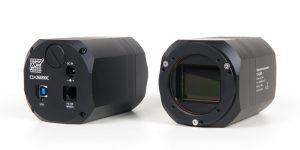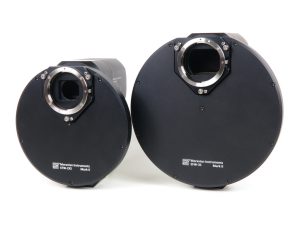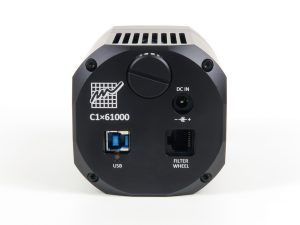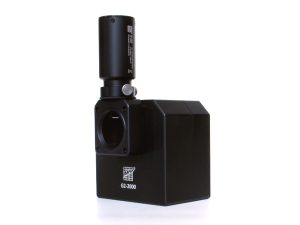Moravian Instruments C1× cameras employ the same sensors as the company’s C3 series offering the latest generation of Sony APS and Full-Frame (24 × 36 mm) CMOS sensors that deliver exceptional quantum efficiency thanks to back-illuminated design and very low dark current. The C1× camera line includes the C1×26000 and C1×61000 cameras.
 Despite relatively small pixels, full-well capacity exceeds 50 ke-. Combined with full 16-bit digitization and perfectly linear response to light these cameras are suitable for both aesthetic astro-photography as well as astronomical research. At the same time, the C1× camera head is designed to be symmetrical, with as small front cross-section as possible.
Despite relatively small pixels, full-well capacity exceeds 50 ke-. Combined with full 16-bit digitization and perfectly linear response to light these cameras are suitable for both aesthetic astro-photography as well as astronomical research. At the same time, the C1× camera head is designed to be symmetrical, with as small front cross-section as possible.
The Moravian Instruments Model C1×26000 camera incorporates the Sony IMX571 CMOS sensor with a resolution of 6252 × 4176 pixels, 3.76 × 3.76 μm pixel size and 23.51 × 15.70 mm image area.
The Moravian Model C1×61000 camera incorporates the Sony IMX455 sensor with a resolution of 9576 × 6388 pixels, 3.76 × 3.76 μm pixel size and 36.01 × 24.02 mm image area.
The Moravian Instruments C1× Cameras combine large APS and Full-Frame sized sensors, used in the C3 series, with a compact body of C1+ cameras. The front cross-section of the C1× camera head is the same as the C1+, only its body is a bit longer to accommodate more complex electronics as well as more powerful cooling (here originates the name of the entire series – C1 eXtended). As with the C1+ line, the C1× cameras do not include a mechanical shutter.
Using large sensors up to size 24 × 36 mm also required redesign of the telescope/lens adapters of the C1× line. The M42/M48 × 0.75 threads, used with C1+ camera adapters, are too small for such large sensors. So the C1× adapters are equipped with a new M56 × 1 thread. The front plate of the M56 × 1 adapter also contains four threaded holes, which makes it compatible with C3 camera body and thus the C1× can use the same external filter wheels and other accessories as the C3 line.
Software Support
Software and driver support allow the usage of C1× camera without the need to use 3rd party software package thanks to included free SIPS software package. However, ASCOM (for Windows) and INDI (for Linux) drivers and Linux driver libraries are shipped with the camera, providing a way to integrate the C1× camera with broad variety of camera control programs.
The C1× cameras are designed to work in cooperation with a host of PC’s. As opposed to digital still cameras, which can operate independently of a computer, scientific cooled cameras usually require a computer for operation control, image download, processing and storage etc.
To operate the camera, you need a computer which:
– Is compatible with the PC standard and runs modern 32 or 64-bit Windows operating system.
– Is an x86 or ARM based computer and runs a 32 or 64-bit Linux operating system. Drivers for 32-bit and 64-bit Linux systems are provided, but the SIPS camera control and image processing software supplied with the camera requires the Windows operating system.
– Support for x64 based Apple Macintosh computers is also included. Only certain software packages are currently supported on Mac.
Moravian Instruments C1× Cameras are designed to be attached to a host PC through a very fast USB 3.0 port. While C1× cameras remain compatible with the older (and slower) USB 2.0 interface, image download time is significantly longer.
Alternatively, it is possible to use the Moravian Camera Ethernet Adapter device. This device can connect up to four Cx (and CCD based Gx) cameras of any type (not only C1×, but also C1, C2, C3 and C4) and offers a 1 Gbps and 10/100 Mbps Ethernet interface for direct connection to the host PC. Because the PC then uses TCP/IP protocol to communicate with the cameras, it is possible to insert a WiFi adapter or other networking device to the communication path.
The USB standard allows the usage of a cable no longer than approximately 5 meters and USB 3.0 cables are even shorter to achieve very fast transfer speeds. On the other side, the TCP/IP communication protocol used to connect the camera over the Ethernet adapter is routable, so the distance between camera setup and the host PC is virtually unlimited.
Download speed is naturally slower when the camera is attached over the Ethernet adapter, especially when compared with direct USB 3 connection.
The C1× cameras need an external power supply to operate. It is not possible to run the camera from the power lines provided by the USB cable, which is common for simple imagers. C1× cameras integrate highly efficient CMOS sensor cooling, shutter and a filter wheel, so their power requirements significantly exceed USB line power capabilities. Also using a power source eliminates problems with voltage drop on long USB cables or with drawing of laptop batteries etc.
C1× Camera Overview
The Moravian Instruments C1× Cameras camera head is designed to be as small and compact as a cooled camera with large sensor can be and at the same time to be robust and resilient.
C1× cameras are equipped with a tiltable telescope interface and tripod mounting threaded holes. They are also are compatible with Moravian external filter wheels designed for larger C2 and C3 cameras as the camera head contains a connector to control the filter wheel. If the external filter wheel is used, the tiltable mechanism on the camera head is not accessible and tiltable adapters for external filter wheels are used. C1× cameras with external filter wheels are compatible with vast range of other telescope and lens adapters including off-axis guider adapters etc.
The C1× camera head is designed to be easily used with a set of accessories to fulfil various observing needs. Camera adapter base back focal distance is 16.5 mm and can be used directly to attach the camera to the telescope focuser using the M56 × 1 thread.
The M56 × 1 thread in the adapter base is also used to attach several adapters for specific mounting standards:
– M42 × 0.75 (T-thread) adapter with 55 mm back focal distance.
– M48 × 0.75 adapter with 55 mm back focal distance.
– Canon EOS bayonet lens adapter.
– Nikon bayonet lens adapter.
External Filter Wheel
The adapter base is also equipped with four M3 threaded holes 44 mm apart. As the adapter base BFD is 16.5 mm – the same BFD as in the case of C2 and C3 cameras – it is possible to attach a Moravian Mark Series External Filter Wheel to the C1× camera. Four sizes of external filter wheels, capable to accept various sizes of filters, are available for the C1× cameras:
 Extra small “XS” size wheel for:
Extra small “XS” size wheel for:
– 7 unmounted D36 mm filters
Small “S” size wheel for:
– 5 square 50 × 50 mm filters
– 7 unmounted filters D50 mm or filters in 2” threaded cells
– 10 unmounted filters D36 mm filters
Medium “M” size wheel for:
– 5 square 50 × 50 mm filters
– 7 unmounted filters D50 mm or filters in 2” threaded cells
– 10 unmounted filters D36 mm filters
Large “L” size wheel for:
– 7 square 50 × 50 mm filters
– 9 unmounted filters D50 mm or filters in 2” threaded cells
If a external filter wheel is used, the tiltable base directly on the camera head stays inactive. Instead, another tiltable base, intended for C3 adapters, is manufactured directly on the External filter wheel front shell. So, if the External filter wheel is used, adapters for the M56 × 1 thread cannot be used. Instead, adapters designed for C3 cameras, must be used.
There are two sizes of adjustable adapters available, depending on the external filter wheel size:
– Extra small ‘XS’ and small “S” External filter wheels use small “S” adapters, compatible with C2 cameras. These adapters include M48 × 0.75 and M42 × 0.75 threaded adapters, Canon EOS and Nikon bayonet adapter, 2” barrel adapter, etc.
– Medium “M” and Large “L” External filter wheels use large “L” adapters, compatible with C4 cameras, intended for large diameter attachments between camera and telescope, such as a M68 × 1 threaded adapter or C3-OAG, which is also equipped with M68 × 1 thread.
C1× cameras are equipped with Sony IMX rolling shutter back-illuminated CMOS detectors with 3.76 × 3.76 μm square pixels. Despite the relatively small pixel size, the full-well capacity over 50 ke- rivals the full-well capacity of many CMOS sensors with much greater pixels and even exceeds the full-well capacity od CCD sensors with comparable pixel size.
The Sony sensors are equipped with 16-bit ADCs (Analog to Digital Converters). 16-bit digitization ensures enough resolution to completely cover the sensor’s exceptional dynamic range.
While the sensors offer also lower dynamic resolution (12 and 14 bit), C3 cameras do not utilize these modes. Astronomical images always use 2 bytes for a pixel, so lowering the dynamic resolution to 14 or 12 bits brings no advantage beside the slightly faster download. But cooled astronomical cameras are intended for very long exposures and a fraction of second saved on image download is negligible compared to huge benefits of 16-bit digitization.
Power Supply
The 12 V DC power supply enables camera operation from an arbitrary power source including batteries, wall adapters, etc. A Universal 100-240 V AC/50-60 Hz, 60 W “brick” adapter is supplied with the camera. Although the camera power consumption does not exceed 50 W, the 60 W power supply ensures noise-free operation.
 Power consumption is measured on the 12 V DC side. Power consumption on the AC side of the supplied AC/DC power brick is higher.
Power consumption is measured on the 12 V DC side. Power consumption on the AC side of the supplied AC/DC power brick is higher.
The camera contains its own power supply inside, so it can be powered by unregulated 12 V DC power source and the input voltage can be anywhere between 10 and 14 V. However, some parameters (like cooling efficiency) can degrade if the supply drops below 12 V.
The C1× cameras measure input voltage and provides the information to the control software. Input voltage is displayed in the Cooling tab of the Imaging Camera control tool in the SIPS program. This feature is important especially if you power the camera from batteries.
Thermoelectric Cooling
Regulated thermoelectric cooling can cool the CMOS sensor to approximately 35 °C below ambient temperature. The Peltier hot side is cooled by a fan. The sensor temperature is regulated with ±0.1 °C precision. High temperature drop and precision regulation ensure very low dark current for long exposures and allow proper image calibration.
The cooling performance depends on the environmental conditions and on the power supply. If the power supply voltage drops below 12 V, the maximum temperature drop is lower.
Maximum temperature difference between the sensor and ambient air may be reached when the cooling runs at 100% power. However, temperature cannot be regulated in this case as the camera has no room for keeping the sensor temperature when the ambient temperature rises. Typical temperature drop can be achieved with cooling running at approximately 90% power, which provides enough room for regulation.
Mechanical Specifications
The compact and robust camera head measures only 78 × 78 × 108 mm (approx. 3.1 × 3.1 × 4.4 inches). The head is CNC-machined from high-quality aluminum and black anodized. The head itself contains a USB-B (device) connector, connector for External Filter Wheel and 12 V DC power plug.
The front side of the C1× camera body is not intended for direct attachment of the telescope/lens adapter. It is instead designed to accept a tiltable adapter base, on which the telescope and lens adapters are mounted.
Back focus distance is measured from the sensor to the base on which adjustable adapters are mounted. Various adapters provide back focal distance specific for the particular adapter type (e.g. Canon EOS bayonet adapter back focal distance is 44 mm).
Stated back focal distance is calculated with the glass permanently placed in the optical path (e.g. optical window covering the sensor cold chamber).
Telescope and Lens Adapters
Various telescope and lens adapters for the Moravian Instruments C1× Cameras are available. Users can choose any adapter according to their needs and other adapters can be ordered separately.
 There are two means of connection between the tiltable adapter base on the C1 camera head and actual adapter:
There are two means of connection between the tiltable adapter base on the C1 camera head and actual adapter:
– The M56 × 1 inner thread with 16.5 mm BFD: Adapters for Canon EOS and Nikon lenses and standard M42 × 0.75 (T-thread) and M48 × 0.75 threaded adapters with 55 mm BFD use this thread for connection with the camera. The M56 × 1 thread can act as a camera adapter itself, providing the used telescope system also offers such a thread.
– The cameras include four M3 threaded holes 44 mm apart: The back focal distance of the front side of the tiltable adapter base is 16.5 mm, which is the BFD of the front surface of C2 and C3 cameras without filter wheel. This makes the C1× cameras compatible with a vast set of accessories, intended for C2 and C3 cameras, including external filter wheels, off-axis guiding adapters etc.
Off-Axis Guider Adapter
A Moravian off-Axis Guider adapter (OAG) can be used with the C1× camera only if the external filter wheel is used. Then the C3-OAG with M68 × 1 thread can be attached to the “M” or “L” External filter wheel.
 The OAG contains a flat mirror, tilted by 45° to the optical axis. This mirror reflects part of the incoming light into guider camera port. The mirror is located far enough from the optical axis not to block light coming to the main camera sensor, so the optics must be capable to create a large enough field of view to illuminate the tilted mirror. The C3-OAG is manufactured with M68 × 1 thread with the back focal distance 61.5 mm.
The OAG contains a flat mirror, tilted by 45° to the optical axis. This mirror reflects part of the incoming light into guider camera port. The mirror is located far enough from the optical axis not to block light coming to the main camera sensor, so the optics must be capable to create a large enough field of view to illuminate the tilted mirror. The C3-OAG is manufactured with M68 × 1 thread with the back focal distance 61.5 mm.
The OAG guider port is compatible with C0 and C1 cameras with CS-mount adapter. It is necessary to replace the CS/1.25” adapter with a short 10 mm variant in the case of C1x cameras. Because C1x cameras follow the CS-mount standard, (BFD 12.5 mm), any camera following this standard with 10 mm long 1.25” adapter should work properly with the C3-OAG.
You can learn more about the Moravian Instruments C1× Cameras here.
 And to make it easier for you to get the most extensive news, articles and reviews that are only available in the magazine pages of Astronomy Technology Today, we are offering a 1 year magazine subscription for only $6! Or, for an even better deal, we are offering 2 years for only $9. Click here to get these deals which only will be available for a very limited time. You can also check out a free sample issue here.
And to make it easier for you to get the most extensive news, articles and reviews that are only available in the magazine pages of Astronomy Technology Today, we are offering a 1 year magazine subscription for only $6! Or, for an even better deal, we are offering 2 years for only $9. Click here to get these deals which only will be available for a very limited time. You can also check out a free sample issue here.



